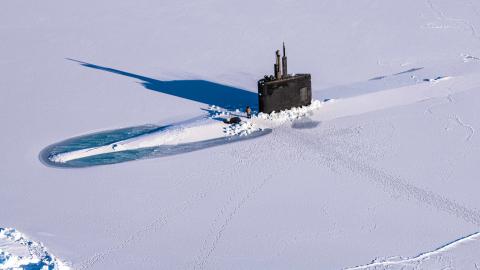The Diplomat author Mercy Kuo regularly engages subject-matter experts, policy practitioners, and strategic thinkers across the globe for their diverse insights into U.S. Asia policy. This conversation with Dr. Liselotte Odgaard, senior fellow at the Hudson Institute, is the 408th in “The Trans-Pacific View Insight Series.”
Identify the factors behind China’s actions in the South China Sea and in the Arctic.
The South China Sea is in China’s home region in East Asia and is a core Chinese interest because of its strategic importance. The area contains considerable energy and fish resources. Militarily, the semi-enclosed sea is a buffer zone for mainland China. The establishment of military bases here allows China to project power against strategic competitors and, if considered necessary, use force against states contesting China’s territorial and maritime zone claims.
By contrast, although China calls itself a near-Arctic state, the Arctic remains a peripheral region far from China’s shores. Here, China establishes a limited, but strategic presence based on the rights of extra-regional states in standard interpretations of international law.
Explain China’s interpretation of sovereignty in the South China Sea and the Arctic.
Chinese sovereignty claims in the South China Sea are complex and increasingly rely on modern concepts of international law, such as the rights of coastal states in exclusive economic zones (EEZs) and Western legal concepts such as effective control. Nevertheless, the claim of the People’s Republic of China (PRC) remains basically an historic claim, founded on the sea’s status as a frontier in the Chinese empire.
In China’s view, there is no dilemma between its use of international law to justify an expanding maritime presence across the world in new strategic frontiers such as the Arctic, and its refusal to adhere to the rights and obligations of international waters in the South China Sea, such as allowing the passage of military vessels without notification and the obligation to cooperate with other states on managing the fishing resources of the sea. In denying these rights, Chinese authorities refer to the sea’s historic status as Chinese, and as such, subject to national legislation. According to China, Western and Japanese conquests from the mid-nineteenth to the mid-twentieth century involved the use of illegal means of force to take territory and maritime space from China. Hence, China defines the status of the South China Sea in accordance with the alleged pre-modern status of the South China Sea as an historic Chinese lake.
China relies heavily on the United Nations Convention on the Law of the Sea (UNCLOS) to protect its ability to navigate the Arctic. The PRC’s 2018 Arctic white paper emphasizes navigation rights, suggesting that it will be inclined to view Arctic waters as international straits for purposes of navigation, bringing China in close alignment with U.S. positions on freedom of navigation in the Arctic. This approach will allow China to prioritize the free passage for all ships, using the Northwest passage along Canada’s coast and the Northern Sea Route along Russia’s coast as international straits.
Analyze how and why China is blurring boundaries in both regions.
China’s Sino-centric legal perspective on the South China Sea appears to be sovereign rights to territory and maritime space based on historical claims as defined by the strongest power and exercised at its discretion. China’s claim to the South China Sea has not been clarified in public. However, the Chinese authorities have not publicly renounced the validity of the official Chinese map of the South China Sea, which contains a tongue-shaped, dashed boundary line that covers at least 80 percent of the area. This suggests that China applies a highly unpredictable ad hoc kind of legal order with blurred boundaries which fails to clarify when other nations are operating in China’s definition of its domestic sovereign area and when they are operating in international waters. China uses the interpretation to justify protecting its economic and strategic interests against other states’ violations of those rights, if necessary by the use of force.
In the Arctic, China seems to respect requests from Canada and Russia to seek permission for passage of the Northwest Passage and the Northern Sea Route, respectively, aligning with their internal waters claims in these areas. However, China’s emphasis on navigation in its 2018 white paper on the Arctic suggests that it defines these areas as international straits. China’s contradictory behavior emphasizes the interconnectedness of China’s Arctic policy with Chinese economic and strategic interests while concurrently avoiding to choose sides between conflicting legal positions of other Arctic powers.
Examine the effectiveness of actors’ responses in both regions towards China’s behavior.
China has tested U.S. legal consistency with UNCLOS by sending navy vessels within 12 nautical miles of the Aleutian Islands off Alaska and bordering the southern edge of the Bering Strait without prior notification, in line with official U.S. interpretations. The U.S. government responded that China’s transit was legal and conducted in accordance with UNCLOS. The United States has regularly performed innocent and non-innocent passage within 12 nautical miles of Chinese-occupied features in the South China Sea in violation of China’s view of its sovereign rights. Washington has refrained from authorizing passage through the Qiongzhou Strait between Guangdong Province and Hainan Island, which is the geographical equivalent of the transit route of the Chinese navy vessels off the coast of Alaska, but which China defines as internal waters. China’s position on the Northwest Passage is complicated by the internal waters claim in the Qiongzhou Strait, which prohibits international navigation without Chinese permission. Nevertheless, the Qiongzhou Strait has rarely, if ever, been a matter of debate.
Such discrepancies in China’s legal positions imply that the U.S. and its allies and partners could do more to call China’s bluff.
Assess the strategic implications of China’s attempt to globalize the Arctic and potential geopolitical and geo-economic risks for U.S., European, and other key stakeholders.
Beijing uses UNCLOS to globalize the Arctic, justifying transit rights for powers from outside the region and the pursuit of economic and scientific engagements that allows it a strategic presence. China is working with Russia on expanding the economic potential of the Northern Sea Route, investing in energy, digital and transport infrastructure, participating in scientific expeditions with other nations, allowing China to obtain situational awareness, and participates in military exercises to add muscle to Russia’s regional military buildup. China may already transit the region with frigates with ice-strengthened hulls since such features cannot be detected from the outside. In five to ten years, China may be ready to patrol the Arctic with nuclear ballistic missile submarines (SSBNs) to mirror U.S. transits in China’s maritime neighborhood in East Asia.
It is urgent that NATO prepare for a strategic normalization of the region that is already well underway. This involves investing in capabilities such as ice-strengthened frigates with anti-air and anti-submarine capabilities that can detect SSBNs transiting through the Bear Gap near Svalbard and along the coast of eastern Greenland without being detected.

















